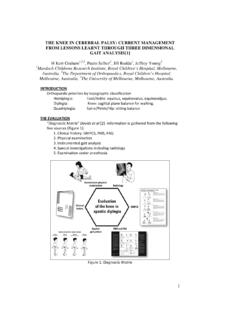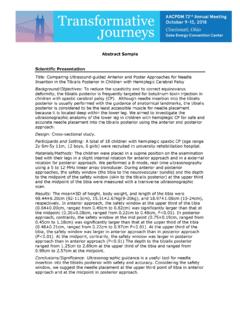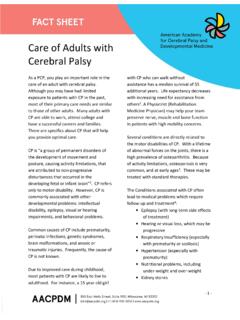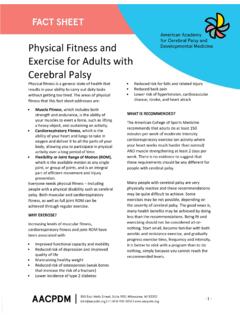Transcription of Introduction to the Pediatric Evaluation of Disability ...
1 Introduction to the Pediatric Evaluation of Disability Inventory Computerized Adaptive Test (PEDI-CAT) for Children with Cerebral Palsy A New Option for Measuring Function in Daily Activities, Mobility, Social/Cognitive and Responsibility Maria Fragala-Pinkham PT, DPT, MS. Benjamin Shore MD, MPH, FRCSC. Jessica Kramer PhD, OTR/L. Disclosures Financial: Benjamin Shore has no financial disclosures to report. Non-financial: He has no non-financial disclosures to report. Financial: Jessica Kramer has no financial disclosures to report. Non-financial: She has a professional non-financial relationship with CRECare; she is the senior author of the PEDI-PRO and a contributing author of the PEDI-CAT/PEDI-CAT (ASD).
2 Disclosure Information AACPDM 69th Annual Meeting | October 21-24, 2015. Speaker Name: Maria Fragala-Pinkham Disclosure of Relevant Financial Relationships I have the following financial relationships to disclose: I am one of the senior authors of the PEDI-CAT. Consultant for: provide consultation to CRECare related to PEDI-CAT. Grant/Research support from: Subaward from BU/CRECare to Franciscan Hospital for Children Royalties from: None Stockholder in: None Honoraria from: None Employee of: Franciscan Hospital for Children Disclosure of Off-Label and/or investigative uses: I will discuss investigational use/future research related to development of the PEDI-CAT in my presentation Objectives Describe the transition from the Pediatric Evaluation of Disability Inventory (PEDI) to the Pediatric Evaluation of Disability Inventory Computer Adaptive Test (PEDI-CAT).
3 Identify the PEDI-CAT test applications including intended populations, domains, test items, response scales, administration procedures, and scoring. Discuss applicability of the PEDI-CAT to measure abilities in youth with disabilities including psychometric properties specifically for youth with CP (GMFCS Levels I-V). Discuss future development and preliminary findings of the PEDI-CAT: ASD option as well as other Disability specific PEDI- CAT options and the new PEDI self report (PEDI-PRO). Pediatric Evaluation of Disability Inventory (PEDI) Stephen M. Haley PT, Ph,D, Wendy J. Coster PhD, OTR/L, Larry H. Ludlow PhD, Jane Haltiwanger PhD, Peter Andrellos PhD. Published in 1992.
4 First Pediatric measure to assess function rather than development Translated into multiple languages and validated for multiple cultures Applications: 1) Document functional delay 2) Document changes in functional abilities over time in response to therapeutic intervention PEDI: The Positives Document functional delay or changes in functional abilities after therapeutic interventions Program Evaluation to document functional status in groups of children and changes over time Document functional skill acquisition in clinical populations and the importance of recognizing cultural differences Minimal training, low cost to administer PEDI: The Criticisms Lengthy administration time (60min).
5 Skills are at the lower end of the continuum Items focused primarily on home-based activities, which creates difficulties for therapists to answer questions without parent input Original standardization sample had some sampling error due to a lack of geographical representation and small numbers in each age group, which can affect the validity of interpretations made using norm-referenced scores From PEDI PEDI-CAT. 2003 - transition to computer adaptive testing began Pompe PEDI (expanded self-care and mobility domains adding items on both ends of the easy to hard continuum normed to age 15 years). PEDI-MCAT (M=multi-dimensional; Pompe PEDI but use of both self-care and mobility simultaneously for item administration).
6 Today's final PEDI-CAT - released October, 2012. Pediatric Evaluation of Disability Inventory-Computer Adaptive Test For children and youth ages 0 - 20 years Can be used across all diagnoses, conditions and settings Focuses on activities and participation in life tasks Can be completed by a parent independently Brief yet precise What is Computer Adaptive Testing (CAT)? Administered only on the computer -No paper and pencil' version available! Uses artificial intelligence to select only most relevant items from a pool' of validated items Each item in the pool' represents a different amount of difficulty,' from most easy to most difficult to perform What is CAT? Item Banks I can try on clothes in a 80.
7 Store dressing room 70. I can tighten screws and High bolts on a wheelchair 60 I can take off jeans 50 I can put on sweatpants Moderate I can clean my upper body 40. I can use a fork (one hand). 30. I can wash my face Low I can take off my hat 20. I can rub my eyes 10. What is Computer Adaptive Testing (CAT)? Set of calibrated items that describe one domain (item banks). Not every item needs to be answered to get a score For each domain, all respondents begin with the same question in the middle of the scoring range Depending on the initial response will dictate if a harder or easier item will be administered next How does item selection occur? Response to the starting question 4 (Easy) High Select a High.
8 Question Starting Question: 3 (A Little Select a Stands alone for a Hard) Medium Medium . few minutes question 1 (Unable) or 2 (Hard). Low Select a Low . question What is Computer Adaptive Testing? With each new response, the score & CI are re-estimated CAT software then determines whether the pre-set stopping rule has been satisfied (level of precision or a number of items). If satisfied= Domain ends & score is provided If not satisfied= New items administered until the stopping rule is satisfied Computer Adaptive Testing CATs used as measure in community reintegration, behavioral health, quality of life, headaches, behavioral health and more . PEDICAT. Accurate & Precise Increased efficiency Reduced respondent burden PEDI-CAT is available for iPads & PCs Each download includes English & Spanish versions PEDI-CAT.
9 Intended Population: Children and youth (birth through 20 years of age) with physical and/or behavioral conditions Applications: Identification of functional delay Examination of improvement for an individual child after intervention Evaluation and monitoring of group progress in program Evaluation and research PEDI-CAT Features Age, gender and mobility device filters prevent irrelevant items from being presented Items worded using everyday language & clear examples Can be completed by the child's caregiver(s) or by the child's therapist/clinician Equations available to link previous PEDI Functional Skills Self-care, Mobility and Social Function scores to the PEDI- CAT so that clinicians may continue to track a child's changes over time Administration of the PEDI-CAT.
10 No special environment, materials or activities necessary Focuses on typical performance at the present time Can be used on multiple occasions for the same child ( initial, interim, discharge and follow-up). No minimum time must pass between assessments Recommendation: review of the PEDI-CAT Manual prior to administration to familiarize self with administration procedures, instrument content, item intent, response scales and score interpretation Domains of the PEDI-CAT. 4 Domains: Daily Activities Mobility Social/Cognitive Responsibility Each domain is self-contained and can be used separately or with other domains Illustrations of Daily Activities and Mobility items are included to facilitate understanding of the item intent The ICF as a conceptual framework PEDI-CAT Domains 3 domains aligned with ICF Activity dimension, the execution of discrete tasks Daily Activities Social/ Cognitive Mobility One domain aligned with ICF participation dimension, involvement in a life situation Responsibility PEDI-CAT = Response Scales For Daily Activities, Mobility and Social/Cognitive.






